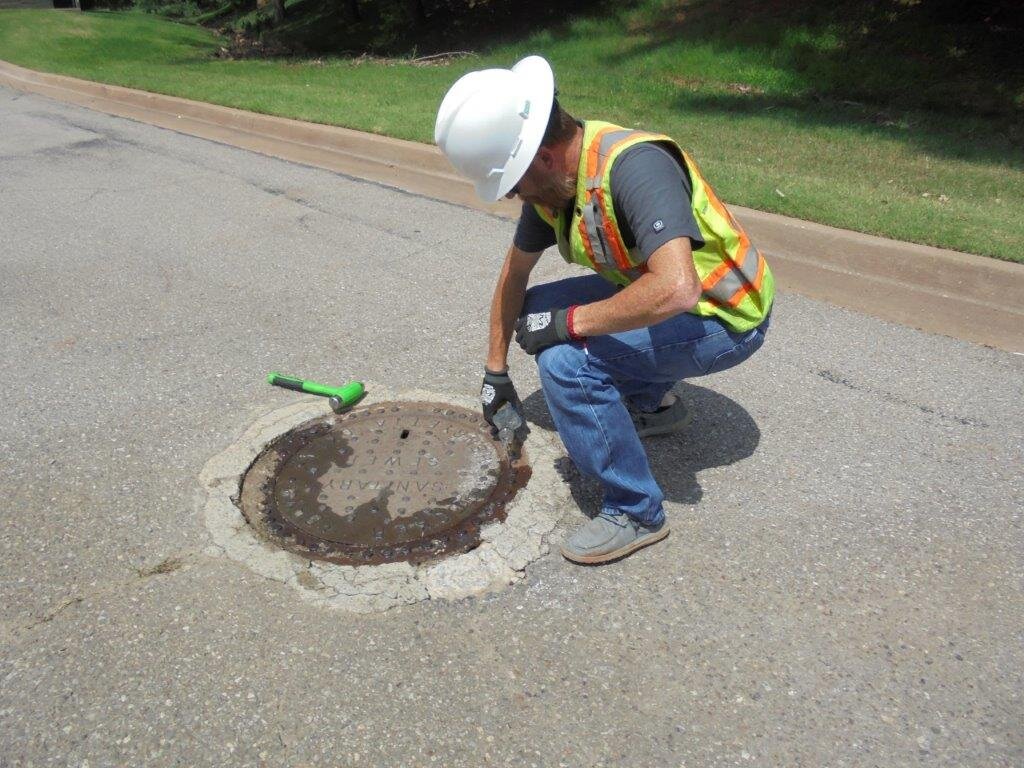“An ounce of prevention is worth a pound of cure.”- Benjamin Franklin. For far too long we in Oklahoma have been ignoring our sanitary sewer systems. Just like our personal health, if we do not practice a proactive approach to maintaining our aging systems, we will encounter costly consequences to our sewer systems sooner or later. If we take measures to maintain our sewers, we can minimize costly repairs and rehabilitations. It is time to stop putting “band aids” on our sewer lines and get them in shape. Here are 11 steps to help you get started on your sanitary sewer line maintenance program.
Use Global Information System (GIS) mapping to understand your system. An effective sewer maintenance program revolves around knowing the location of all infrastructure, pipe sizes, length and depth of lines, types of pipe and materials used in manholes. Accurate GIS mapping can help track completed rehabilitation and replacement work, but it begins with identifying exactly where manholes and lamp holes are located.
Inspect manholes on a schedule. Depending on the size of your system and staff availability, this may be once a year or every other year. Inspecting manholes will alert you to issues such as excessive debris and blockages, structural issues, and inflow and infiltration sources. Keep records using manhole inspection forms to track maintenance and rehabilitation needs.
Perform Draw Down Tests if you have lift stations. The test verifies proper pump performance and should be conducted annually at every lift station to identify issues with floats, isolate excessive grease, and confirm check valves are functional. You might want to check the Air Relief pits to make sure the ball valves are operating efficiently while you are doing the tests.
Verify your municipality has an ordinance requiring grease traps at businesses. Restaurants, gas stations, car washes, and other businesses that discharge fats, oils, and grease (FOG) should install a grease trap to avoid clogging the sewer system. Perform random inspections to ensure proper installation and maintenance of grease traps.
Do construction observations on sanitary sewer installations for new developments. Sanitary sewers that are not properly bedded are a major problem that leads to further problems for the municipality down the road. Offset frames and covers, chimney damage, and broken pipe are just a few problems resulting from improper new construction. Make sure your sewer mains are identified prior to trenching, drilling, or boring projects to avoid conflicts with your system. Before a developer passes new infrastructure on to the municipality, make sure to perform mandrel testing on sewer mains, and vacuum tests on manholes to confirm proper construction. Also conduct a warranty inspection prior to the warranty expiration to verify whether issues with materials or workmanship have developed during the warranty period.
Establish a routine cleaning and jetting program on sewer mains. This process will remove debris buildup and attached deposits to ensure your system is flowing properly and capacity is not being compromised. Jetting and cleaning at least 30% of your system annually so that all lines have been cleaned on a 3-year rotational basis will save a lot of headaches down the road.
Perform closed circuit television (CCTV) inspections. After cleaning and jetting, conduct CCTV inspections of the sewer mains to identify leaks or defects in the pipe system.
Conduct sump pump inspections. These residential inspections will identify connections to the sewer system. Have an ordinance prohibiting illicit sump pump connections.
Perform smoke testing. Smoke testing is a quick and efficient method for detecting storm water connections, roof drain connections, or defective sewer laterals, all of which are contributors to inflow & infiltration (I&I).
Conduct wet weather inspections. These can provide valuable information on how precipitation and groundwater conditions affect the flow in your system. Manholes may appear in good condition when it is dry, but they may exhibit leaking joints, missing mortar, and in-flow lid leaks in low-lying areas during wet-weather inspections.
Prepare an Operations & Maintenance (O&M) Manual for your sanitary sewer system. An O&M Manual will contain information on your maintenance schedules, identify how to report sanitary sewer overflows, have an emergency contact list, and spell out inspection procedures which can be helpful when training new sewer staff. It provides invaluable references for both sewer maintenance workers and administrators when it comes time to budget for repairs, rehabs, and rebuilds.
It is time to stop wasting your time “putting out fires” on all the repairs required due to past negligence. Maintaining a sewer system takes time and commitment, but just like eating right and exercising helps keep a heart healthy, performing sanitary sewer maintenance regularly will greatly improve the health of your sewer system. And we all know preventing a problem saves time and costs less than fixing it after an SSO event happens.



